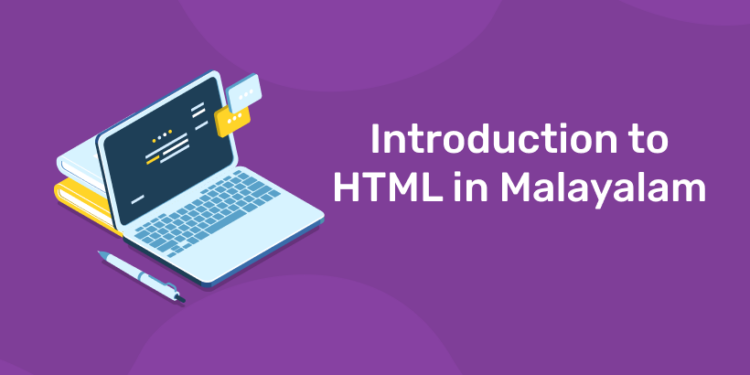Table of Contents
Introduction to HTML in Malayalam: HTML stands for HyperText Markup Language and is the foundation of web development. It is a programming language used to create webpages and websites and is the key to creating exciting and engaging digital experiences. In this blog, we will be introducing HTML in Malayalam, giving you the tools and knowledge you need to create dynamic websites and web pages. The essentials of HTML will be covered, including environment setup, code creation, and execution. Here, we shall introduce the basis of HTML in Malayalam, providing an easy-to-understand guide for beginners. We will be discussing the fundamentals and how to use HTML to build websites and applications. With our guidance, you can learn HTML and become a proficient web developer. So, let’s get started!
Are you aspiring for a booming career in IT? If YES, then dive in |
||
Full Stack Developer Course |
Python Programming Course |
Data Science and Machine Learning Course |
What is HTML? Definition
Introduction to HTML in Malayalam: HTML stands for Hyper Text Markup Language. It is the standard markup language for documents intended to view in a web browser. HTML is often aided by technologies like Cascading Style Sheets (CSS) and programming languages such as JavaScript.
Web browsers embrace HTML documents from a web server or local storage and convert them to multimedia web pages. HTML describes the structure of a web page semantically and originally included cues for its appearance.
How Does HTML Work?
Introduction to HTML in Malayalam: HTML instructs the internet browser on how to display the page. To begin, the author creates an HTML document on their computer using a basic text editor tools (such as TextEdit for Mac). The author then inserts HTML tags to populate their HTML document with a succession of HTML elements.
🚀 Start Coding Today! Enroll Now with Easy EMI Options. 💳✨
💻 Master Web & Android Development! Build cutting-edge apps and websites from scratch. 🚀 Start your tech journey today!"
Start Learning Now with EMI OptionsWhat are the Basics of HTML?
| Event | Details |
| Full Form | Hyper Text Markup Language |
| Latest Version of HTML | HTML5 |
| Filename Extension | .html
|
| Type Code | TEXT |
| Uniform Type Identifier (UTI) | public.html |
| Developed by | WHATWG |
| Container for | HTML Elements |
| Container By | Web Browser |
| Extended to | XHTML |
Experience the power of our web development course with a free demo – Enroll Now!
History of HTML: Timeline
| Year | Version |
|---|---|
| 1989 | Tim Berners-Lee invented www |
| 1991 | Tim Berners-Lee invented HTML |
| 1993 | Dave Raggett drafted HTML+ |
| 1995 | HTML Working Group defined HTML 2.0 |
| 1997 | W3C Recommendation: HTML 3.2 |
| 1999 | W3C Recommendation: HTML 4.01 |
| 2000 | W3C Recommendation: XHTML 1.0 |
| 2008 | WHATWG HTML5 First Public Draft |
| 2012 | WHATWG HTML5 Living Standard |
| 2014 | W3C Recommendation: HTML5 |
| 2016 | W3C Candidate Recommendation: HTML 5.1 |
| 2017 | W3C Recommendation: HTML5.1 2nd Edition |
| 2017 | W3C Recommendation: HTML5.2 |
What are the 4 Rules of HTML
- Respect Syntax and Semantics
- Don’t Use Presentational or Behavioural Markup
- Anything not absolutely necessary should be left out.
- Bounce
🚀 Start Coding Today! Enroll Now with Easy EMI Options. 💳✨
💻 Master Web & Android Development! Build cutting-edge apps and websites from scratch. 🚀 Start your tech journey today!"
Start Learning Now with EMI OptionsWhy Learn HTML?
- It is used to build websites.
- It aids in the development of web programming fundamentals.
- Improve your professional career
- It is supported by all browsers
What is an HTML Element?
A start tag, some content, and an end tag define an HTML element:
<tagname> Content </tagname>
<h1>My First Heading</h1>
<p>My first paragraph.</p>
be a full stack developer ! join now !
Top 10 Commonly Used HTML Tags List
<a>for link<h1>… for titles- <h1>Heading 1</h1>
- <h2>Heading 2</h2>
- <h3>Heading 3</h3>
- <h4>Heading 4</h4>
- <h5>Heading 5</h5>
- <h6>Heading 6</h6>
<b>to make bold text<strong>for bold text with emphasys<i>to make an italic text
<body>main HTML part<p>for paragraph<br>for break<div>it is a division or part of an HTML document<img>for images in document<ol>is an ordered list,<ul>for an unordered list<li>is a list item in bulleted (ordered list)
<span>to style part of text
Page Structure of HTML
- <DOCTYPE html>: This is the statement of the document type (not a tag). It identifies a document as an HTML document. The doctype declaration is not case sensitive.
- <html>: This is known as the HTML root element. It contains all other components.
- <head>: The head tag holds the “behind the scenes” elements for a webpage. Elements in the head are not visible on the front end of a website. The following HTML elements are used inside the <head> element:
- <style> With the use of CSS, this html tag enables us to add styling to our webpages and make them visually appealing.
- <title>- The title displayed on the top of your browser when you visit a website
- <base>-It specifies the base URL for all relative URL’s in a document.
- <noscript>–Defines a section of HTML that is inserted when scripting is disabled in the user’s browser.
- <script>- A tag which Used to add functionality in the website with the help of JavaScript.
- <meta>-This tag encloses the website’s meta data, which must be loaded each time the website is viewed.
- <link>– The ‘link’ tag is used to tie together HTML, CSS and JavaScript. It is self closing.
- <body>: The body tag is used to encompass all of a webpage’s viewable content. In other words, the browser will display the body content on the front end.
Example: This sample demonstrates the fundamental structure of HTML code.
<!DOCTYPE html>
<html>
<head>
<meta charset=”UTF-8″>
<meta name=”viewport” content=”width=device-width, initial-scale=1.0″>
<!–The above meta characteristics make a website compatible with different devices. –>
<title>Demo Web Page</title>
</head>
<body>
<h1>Introduction to HTML in Malayalam</h1>
<p>What is HTML</p>
</body>
</html>
Experience the power of our web development course with a free demo – enroll now!









